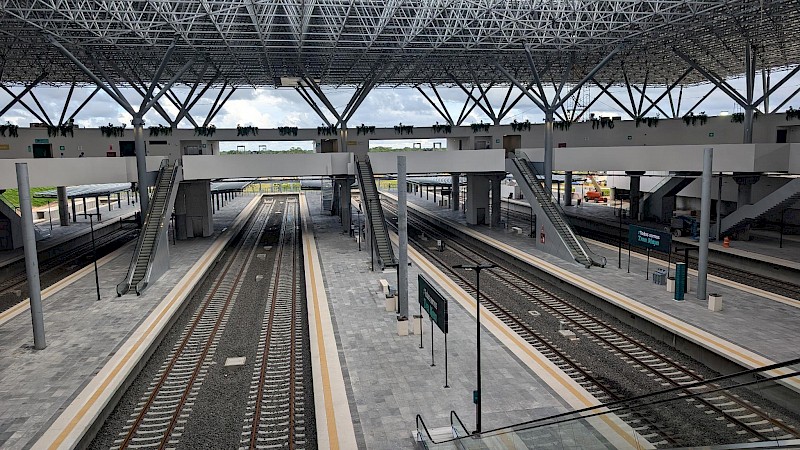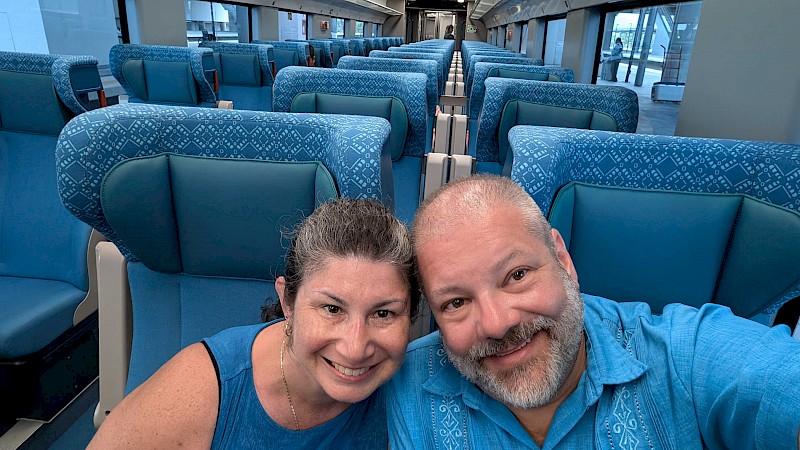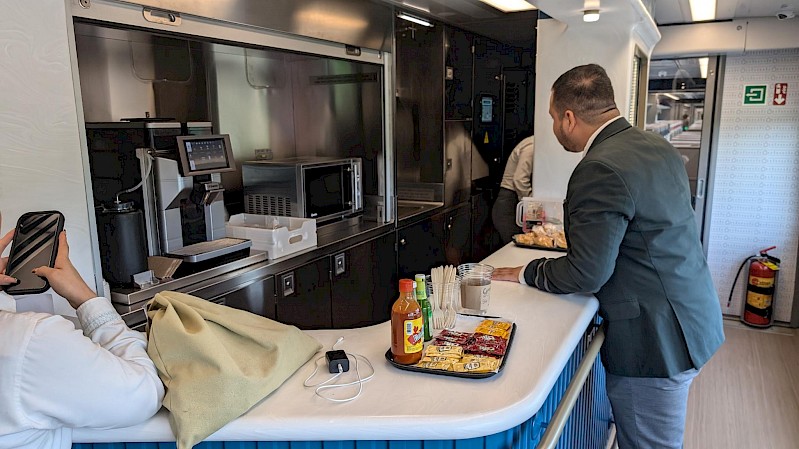Happening Now
Tren Maya: A New Way to Travel in Mexico’s Yucatán
October 4, 2024
A guest blog by Rail Passengers Board Vice-Chair Emeritus Tom Girsch
During our fall vacation, Laura and I had the opportunity to try out the new Tren Maya service which started running earlier this year. I thought I’d share our experiences, as well as some background on the train and the controversy surrounding it. We rode two legs: from Cancún to Chichén Itzá and from there to Mérida.
First, no discussion of the Tren Maya would be complete without addressing the controversy surrounding its construction. Unlike in the U.S., where projects like this can be held up for years for environmental review, the Mexican government gave environmental concerns short shrift, leading to much consternation and local backlash. This is especially true for the section between Cancún and Tulum, where an extensive system of cenotes and underground rivers is crucial to the local ecosystem. Habitat fragmentation is also a major concern. Further, locals fear that rather than diverting car traffic to the train, this service will simply attract ever more tourists to an area that’s already overcrowded with them. I encourage you to read more, e.g., here.
As for the route, when fully completed, Tren Maya will run east from Palenque in the state of Chiapas and serve a loop through the states of Campeche, Yucatán and Quintana Roo. As of this writing, however, only the northern part of the loop is in operation, stretching from Palenque to Tulum. I was unable to find timetables, so I used a trial-and-error method to determine frequencies. The Cancún to Tulum leg runs only a single daily round-trip, with no connections available to the rest of the service. So, it’s really only useful for a day trip down to the ruins at Tulum. There seem to be four daily trips between Cancún and Mérida, with two of those extending west to Palenque. But as I’ll explain in a bit, the Mexican government has much grander ambitions for the service.
Booking our tickets proved challenging. All sales occur through an official website, and it appears as though they release tickets for an entire month at a time, but only do so a few days before that month begins. So, while I was able to find plenty of tickets for September dates weeks in advance, I wasn’t able to book our October 1 and October 3 legs until around the 29th of September. Not great for planning ahead. Nonetheless, once the tickets finally became available for purchase, we had no trouble finding seats on our desired departures. It’s also important to note that international travelers pay a higher price for tickets than Mexican citizens. So, when booking, be sure to select the correct fare type. All seating is reserved, so you’re able to select your seats at time of booking. The seat map helpfully includes an indication of the direction of travel, which would be a nice touch if it were accurate. [Spoiler: It wasn’t.]
One look at any of the major stations along the route gives a good idea of how ambitious this project is and how serious México is about expanding it. We started our trip in Cancún, at a huge station just a couple of kilometers from the airport. There are free shuttles between the airport and the train station, but as of yet, no direct shuttle service between the station and the hotel zone. There were quite a few shuttle buses parked in the lot, leading me to believe that they do eventually intend to offer that type of service. We ended up paying about $30 extra for our airport shuttle to take us directly to the train station instead.
And what a station. Ten platforms, and a lot of as-yet-unused space for retail. It’s clear that they intend to run a lot more than the current four daily trains.

The Chichén Itzá station, while similarly ambitious, is far from ready for prime time. Only one platform is operating. None of the retail is open there, and the only local connection is a shuttle bus to the nearby pueblo of Piste, principally used by locals. We learned the hard way that if traveling there, it’s best to make sure your transportation to your hotel is pre-arranged. We had to have the ticket agent call a taxi for us and waited about 20 minutes. The cost was MXN$200, or a little more than US$10. The current road to and from the station is in terrible shape, so the ride to our hotel was a bit of an adventure. They’re allegedly building a new one that will lead to a new entrance to the historical site and provide more convenient access to the nearby hotels.
The Mérida station was the closest to complete, with much of the retail space already operating. There’s even a rental car counter there. Which you might need, since the station is on the Southeast edge of town, a solid 25 minutes from the historic center. We ended up taking an Uber to our hotel.
The trains themselves are nice without being particularly fancy. I was reminded of the circa-2000 Cascades trainsets. Our consist had an engine, three “tourist” class coaches and one “premier” class coach. One of the tourist coaches had a small cafe section. The tourist coaches have a 2-2 seating configuration with roughly half the seats facing each direction, not unlike many Amtrak corridor trains. The base of the seats is about 17 inches wide, but because there’s a bit of space between the seats, you end up with about 19 inches of total width. The seat pitch – that is, the distance between the back of your seat and the back of the seat ahead of you – is about 31 inches.

Premier class gets you a 2-1 seating configuration, with almost all of the seats facing the same direction (which on both of our trains ended up being backward). The premier seat bottoms were 19 inches wide, with about 23 inches of total width, and the pitch was 34 inches. In both the tourist and premier classes, the seats were plush (not leather or vinyl) and the seats “reclined” by sliding the seat bottom forward rather than tilting the seatback into the space behind you.
As far as I could see, the cafe area didn’t have a menu or pricing. Just a selection of visible items, and you had to ask how much they cost. Mainly pre-wrapped sandwiches, candy and chips, with beer, soft drinks, juice and a few liquors available for purchase. The premier service included a snack (chips) and juice, a soft drink or a beer. There’s a currently unused galley section in the premier class coach which leads me to believe they eventually intend to offer something more like Acela First-style food-and-beverage service to premier customers.

The train cars are catenary-capable, but no catenary yet exists. We could see in places where they were starting to build the overhead structures to support catenary. But for our trip, it was diesel all the way. We topped out at a modest-but-respectable 140 kph/88 mph. Point to point, the train was a little faster than driving, but most of that difference is lost getting to and from the stations. The track conditions are certainly good enough to support higher speeds, so I hope that once the catenary is in place, speeds will increase and make the train more advantageous.
Some final thoughts? The Tren Maya has the potential to be a great service, but it isn’t there yet. For us, it still was preferable to driving, but you need to be ready to deal with the growing pains. It’s also helpful to have some knowledge of Spanish, because although most of the staff spoke English, all of the announcements both on-board and in the stations were Spanish-only. We’ll be interested to see what things look like in a year or two, but for now, I’d only recommend it to more adventurous travelers.
"I’m so proud that we came together in bipartisan fashion in the Senate to keep the Southwest Chief chugging along, and I’m grateful for this recognition from the Rail Passengers Association. This victory is a testament to what we can accomplish when we reach across the aisle and work together to advance our common interests."
Senator Tom Udall (D-NM)
April 2, 2019, on receiving the Association's Golden Spike Award for his work to protect the Southwest Chief
Comments